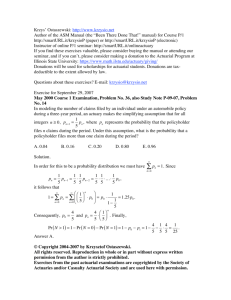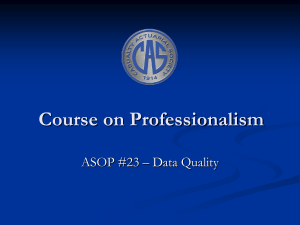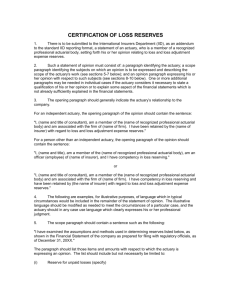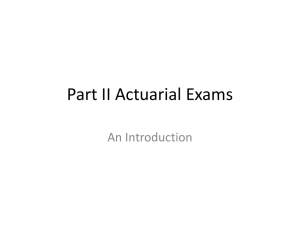ISAP 4 – Discussion on the draft and changes since London
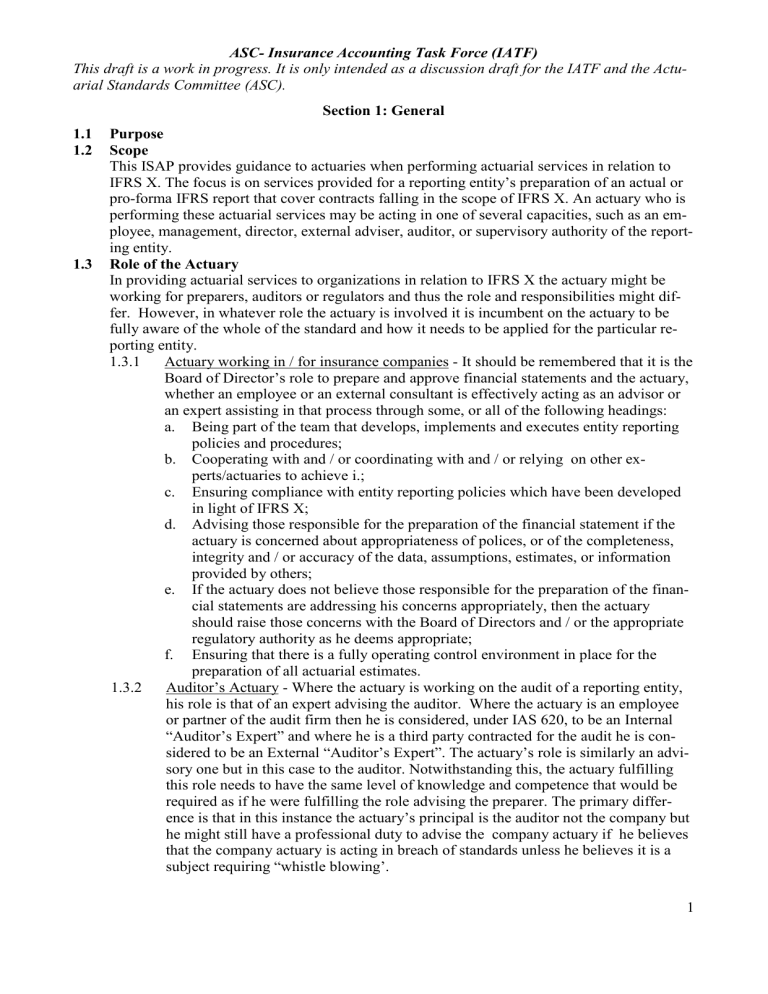
ASC- Insurance Accounting Task Force (IATF)
This draft is a work in progress. It is only intended as a discussion draft for the IATF and the Actuarial Standards Committee (ASC).
Section 1: General
1.1
Purpose
1.2
Scope
This ISAP provides guidance to actuaries when performing actuarial services in relation to
IFRS X. The focus is on services provided for a reporting entity’s preparation of an actual or pro-forma IFRS report that cover contracts falling in the scope of IFRS X. An actuary who is performing these actuarial services may be acting in one of several capacities, such as an employee, management, director, external adviser, auditor, or supervisory authority of the reporting entity.
1.3
Role of the Actuary
In providing actuarial services to organizations in relation to IFRS X the actuary might be working for preparers, auditors or regulators and thus the role and responsibilities might differ. However, in whatever role the actuary is involved it is incumbent on the actuary to be fully aware of the whole of the standard and how it needs to be applied for the particular reporting entity.
1.3.1
Actuary working in / for insurance companies - It should be remembered that it is the
Board of Director’s role to prepare and approve financial statements and the actuary, whether an employee or an external consultant is effectively acting as an advisor or an expert assisting in that process through some, or all of the following headings: a.
Being part of the team that develops, implements and executes entity reporting policies and procedures; b.
Cooperating with and / or coordinating with and / or relying on other experts/actuaries to achieve i.; c.
Ensuring compliance with entity reporting policies which have been developed in light of IFRS X; d.
Advising those responsible for the preparation of the financial statement if the actuary is concerned about appropriateness of polices, or of the completeness, integrity and / or accuracy of the data, assumptions, estimates, or information provided by others; e.
If the actuary does not believe those responsible for the preparation of the financial statements are addressing his concerns appropriately, then the actuary should raise those concerns with the Board of Directors and / or the appropriate regulatory authority as he deems appropriate; f.
Ensuring that there is a fully operating control environment in place for the preparation of all actuarial estimates.
1.3.2
Auditor’s Actuary - Where the actuary is working on the audit of a reporting entity, his role is that of an expert advising the auditor. Where the actuary is an employee or partner of the audit firm then he is considered, under IAS 620, to be an Internal
“Auditor’s Expert” and where he is a third party contracted for the audit he is considered to be an External “Auditor’s Expert”. The actuary’s role is similarly an advisory one but in this case to the auditor. Notwithstanding this, the actuary fulfilling this role needs to have the same level of knowledge and competence that would be required as if he were fulfilling the role advising the preparer. The primary difference is that in this instance the actuary’s principal is the auditor not the company but he might still have a professional duty to advise the company actuary if he believes that the company actuary is acting in breach of standards unless he believes it is a subject requiring “whistle blowing’.
1
ASC- Insurance Accounting Task Force (IATF)
This draft is a work in progress. It is only intended as a discussion draft for the IATF and the Actuarial Standards Committee (ASC).
Before taking on the role of an External Auditor’s Expert, the actuary should consider whether there are any circumstances that may create actual or perceived threats to the expert’s objectivity, such as any direct or indirect financial interests in the reporting entity and / or any business or personal relationships with the reporting entity.
1.3.3
Regulator’s Actuary - Where the actuary is working as part of a regulatory team reviewing the reporting entity and / or its financial statements, the actuary is likely to be fulfilling the role of an expert advising the regulator. The actuary’s role is similarly an advisory one but in this case to the regulator. Notwithstanding this, the actuary fulfilling this role needs to have the same level of knowledge and competence that would be required as if he were fulfilling the role advising the preparer. The primary difference is that in this instance the actuary’s principal is the regulator not the company but he might still have a professional duty to advise the company actuary if he believes that the company actuary is acting in breach of standard unless he believes it is a subject requiring “whistle blowing’.
1.4
Compliance
1.5
Relationship to ISAP1
1.6
Defined Terms
1.7
Cross References
1.8
Effective Date
2
ASC- Insurance Accounting Task Force (IATF)
This draft is a work in progress. It is only intended as a discussion draft for the IATF and the Actuarial Standards Committee (ASC).
Section 2: Appropriate Practices
2.1.
Knowledge of General Requirements
Regardless of the role being fulfilled it is incumbent on the actuary to ensure that he / she has: a.
Detailed knowledge of (and can display being in compliance with) IFRS X, those aspects of other IFRSs / IASs relevant to the engagement, and the reporting entity’s accounting policies; b.
Knowledge and consideration of the reporting entity’s specifications regarding materiality for the engagement; c.
Knowledge and consideration of the reporting entity’s products and operations; d.
Knowledge and consideration of the reporting entity’s appetite for and approach to pricing risk; e.
Knowledge of how the reporting entity’s regulatory environment(s) interface(s) with
IFRS X; f.
If part of the audit engagement, whether as an internal or external expert, knowledge of
IAASB and local auditing standards, in particular any developed for IFRS X, impact of materiality on statements and estimates.
2.2.
Potential supplement to ISAP 1
2.2.1
Process and Model Governance - It seems reasonable to wait for the deliberation of the ASC on the matter whether a model governance standard is a useful way forward. Such a standard could cover most of what would be necessary in ISAP 4 on model governance in relation to IFRS X. Eventually there might be IFRS X related model governance issues in relation financial reporting specificities but these could be very limited. We should perhaps wait and see the development of the general model governance standard.
There might be a specific issue in case of IFRS X in terms of the various lines of defense, i.e. if the actuary who works in a financial reporting capacity belonging to the second line of defense reports to the CFO (first line of defense). This issue may not be there for other ISAPs, e.g. ISAP 3. However this issue (identifying and handling conflicts of interest) may be properly addressed in the general model governance standard.
2.2.2
Quality and completeness of data a.
(Data quality is generally properly handled in ISAP 1:2.5 Data Quality. We did not find any IFRS X related issue here but it does not mean there is none.) b.
Identification of those items specific to the financial statement, that are available for assuring completeness of the data c.
(Effect of data deficiency and related action is settled in ISAP 1:2.5.4 Data Deficiencies. We did not find any IFRS X related issue here but it does not mean there is none.)
2.2.3
Materiality (adapted from ISAP 3, section 2.2) - The actuary should understand the relationship between materiality with respect to the IFRS financial statements and materiality with respect to the actuarial services. a.
When appropriate for the work, the actuary should seek guidance from the principal or reporting entity, as appropriate for the work, regarding materiality with respect to the IFRS financial statements and take that guidance into account when performing the actuarial services. b.
In applying ISAP 1 paragraph 2.4, Materiality, the actuary’s threshold of materiality with respect to the actuarial services should not be greater than the report-
3
ASC- Insurance Accounting Task Force (IATF)
This draft is a work in progress. It is only intended as a discussion draft for the IATF and the Actuarial Standards Committee (ASC). ing entity’s threshold of materiality with respect to the IFRS financial statements. The principal or reporting entity (not the user of the IFRS financial statements) is the intended user of the actuarial services when assessing materiality with respect to the actuarial services. c.
In all following paragraphs of this ISAP, any use of “material” or “materiality” is with respect to the actuarial services.
2.2.4
Proportionality (Trade-off between costs and benefits) (adapted from ISAP 3 section
2.3) - In applying ISAP 1 paragraph 1.5, Reasonnable Judgement, and in particular paragraph 1.5.2, the actuary should take materiality into account. The degree of refinement in specific assumptions or methods recommended by the actuary should be consistent with the impact on the actuarial services. Examples include, all of which are subject to the actuary’s professional judgment:
Identification of those cost elements where proper assessment of the costs vs benefits may have a valid impact on the applied methods and assumptions when the actuarial services are provided according to IFRS X principles including the identification of the cases when the actuary is not required to carry out a deep and exhaustive investigation to explore all potential factors. Generally the principle of proportionality (IS-
AP 1:1.5.2) should apply.
2.3.
Identification and classification of contracts, including combining contracts or separating components of contracts. para. 3-16,
2.3.1
Identification of insurance contracts - When identifying insurance contracts, or classifying contracts as insurance or not insurance, the actuary must be familiar with the definition of an insurance contracts, including the meaning of the key terms in the definition; namely, insurance risk.[citation] The actuary should be familiar with the guidance in Appendix B related to determining the presence of significant insurance risk [citation].
The identification of insurance contacts takes place when contracts are issued, reinsurance is acquired, or in a business combination or in a portfolio transfer. The process of classifying contracts may be repeated when there are modifications to contracts. The actuary should be familiar with the population of products that may be subject to IFRS X. The actuary should understand the characteristics of products and assess and justify whether the contracts under consideration need to be explicitly tested for the presence of significant insurance risk. The actuary should be familiar with and consider the appropriateness of the entity’s policy for evaluating the significance of insurance risk, and the actuary should apply the test to contracts for which it is not apparent that the contracts contain significant insurance risk.
The classification of a contract is made by considering the potential benefits of the contract over the coverage period. [citation] That period includes the coverage that relates to all premiums within the boundary of the insurance contract. The actuary should understand the definition of coverage period and be familiar with the guidance related to the boundary of a contract. The actuary should document the contract boundary as part of the process of classifying contracts.
2.3.2
Contracts specifically or potentially excluded from the scope of IFRS X -
IFRS X excludes certain contracts and makes optional the treatment of certain contracts as insurance. [citation]The actuary should be familiar with the types of contracts that are excluded from the scope of IFRS X and take care not to inadvertently apply IFRS X to these contracts.
4
ASC- Insurance Accounting Task Force (IATF)
This draft is a work in progress. It is only intended as a discussion draft for the IATF and the Actuarial Standards Committee (ASC).
When application of IFRS X to contracts is optional, such as for financial guarantees, the actuary should be aware of the reporting entity’s accounting policy.
2.3.3
Combinations of insurance contracts - The actuary should be familiar with the criteria and situations when insurance contracts must be combined when applying IFRS
X. [citation] The actuary should familiar with and consider the appropriateness of the entity’s process to identify groups of contracts that are issued at or near the same time to a single policyholder or to related policyholders. The actuary should have a process to determine if a group (or subgroup) of these contracts has one of the criteria that requires them to be treated in combination.
2.3.4
Separation of certain components of contracts a.
Embedded Derivatives - An embedded derivative is separated from the host insurance contract if:
It is not “closely related” to the insurance contract, as that term is used in
IFRS 9; and
A financial instrument with the same terms would be a derivative and would fall into the scope of IFRS 9, (e.g., it is not itself an insurance feature).
An embedded derivative that is separated is treated like a stand-alone financial instrument that is initially measured under the guidance IFRS 9. [citation]
The actuary should be familiar with the definitions of derivative and embedded derivative. The actuary should be familiar with the criteria for separation of embedded derivatives from host insurance contracts. [citation]The actuary should be familiar with and consider the appropriateness of the entity’s process for identifying embedded derivatives in insurance contracts and for determining if they should be separated. To measure the fair value of embedded derivatives that have been separated, the actuary should be familiar with the guidance in IFRS 13 for fair value measurement and be knowledgeable about option pricing techniques. The actuary should have a process for applying option pricing techniques, models and input controls which have been validated with available market values, if any, of similar instruments. b.
Investment Components Para 17 e - Investment components are separated from the insurance contract if they are distinct. [citation] Appendix B of IFRS X explains that distinct means that the investment component is not interrelated to the insurance component and it is not like other contracts that are sold, or could be sold, in the market. The actuary should be familiar with and consider the appropriateness of the entity’s process in place to identify investment components in insurance contracts and for determining which, if any, should be separated. c.
Services Components - An insurer must separate a service component from the host insurance contract if it is distinct. [citation]The service component is a performance obligation, as defined in IFRS 15 Revenue from Contracts with Customers, to provide goods or services. Appendix B of IFRS X provides guidance on determining if a service component is distinct. The actuary should be familiar with the concept of a performance obligation in IFRS 15 and with the criteria for separation of service components from host insurance contracts. The service component is distinct if the goods or service are readily available separately or if the policyholder can benefit from the service on its own (i.e., without reference to the insurance benefit). A service component is not distinct if the cash flows and risks associated with the good or service are highly interrelated with the cash flows and risks associated with the insurance components in the contract, and the
5
ASC- Insurance Accounting Task Force (IATF)
This draft is a work in progress. It is only intended as a discussion draft for the IATF and the Actuarial Standards Committee (ASC). entity provides a significant service of integrating the service component with the insurance components.
The actuary should be familiar with and consider the appropriateness of the entity’s process for identifying service components in insurance contracts and for determining if they should be separated.
2.3.5
Recognition and derecogniton of an insurance contract Para. 12-16, 50-51 - The actuary should be familiar with the guidance on recognition.[citation] A contract is recognized on the earlier of the beginning of the coverage period or the date on which the first premium is due, unless the contract belongs to a portfolio of contracts that are onerous at their inception.
The measurement of contracts is as of the beginning of the coverage period with proper consideration given to pre-coverage cash flows. A loss is recognized on onerous contracts as soon as it is apparent that they are onerous. [Citation] The actuary should have procedures in place to identify portfolios of contracts that the may be onerous, and should recognize losses on portfolios that prove to be onerous.
A reporting entity derecognized an insurance contract when the contract is extinguished. [citation] Modification of a contract may cause it to be derecognized, a portion of it to be derecognized, or the recognition of an additional benefit.
2.3.6
Modifications of an insurance contract Para. 49, 52 - The modification may result in loss on recognition or a gain or loss on derecognition. [citation] The actuary should take steps to be aware of contract modification that take place. The actuary should asses any modifications and determine if the modifications require derecognition and recognition of the modified contract, or the recognition of additional benefits under the modified contract. The actuary should be able to quantify gains or losses that result from modifications.
Portfolios/aggregation of contracts - general (more specific as needed in specific topics be-low). This is a general comment because the use of portfolios comes up in several places. We need to indicate if the groupings are always the same or if there are groupings or aggregations that are not characterized as portfolios.
2.4.
Determining the measurement approach PAA or BBA Para. 17
2.4.1
IFRS X allows the Premium Allocation Approach (PAA) to measurement, as an alternative to the Building Block Approach (BBA) under certain conditions. The actuary should be aware that the PAA is not required even if those conditions are met. If the PAA is allowed, there are a variety of reasons why an entity may prefer to use the
BBA anyway. These include (not an exclusive list): a.
Consistency with similar contracts for which the PAA is not allowed; b.
Regulatory valuation requirements consistent, in whole or part, with the BBA; c.
In certain circumstances, the PAA may prove not to be a simplification. This will typically be the case for: i.
contracts with a financing component; ii.
contracts with periodical premiums other than short-term instalments; iii.
contracts with complications such as embedded options.
2.4.2
This choice is a matter of accounting policy, which is not usually modified, once made. In the making of this choice, an actuary may be required, for a class or classes of business: a.
To assess the differences between PAA measurement and BBA measurement; and/or;
6
ASC- Insurance Accounting Task Force (IATF)
This draft is a work in progress. It is only intended as a discussion draft for the IATF and the Actuarial Standards Committee (ASC). b.
To assess the period of coverage from all premiums within the contact boundary at initial recognition; and/or c.
To advise on whether the requirements for PAA measurement are met; and/or d.
To advise on which measurement approach, PAA or BBA, is preferable.
2.4.3
In most cases where PAA measurement is adopted for a class or classes of business, it will be obvious at subsequent durations that the PAA measurement is still appropriate. If this is not the case, the actuary should consider whether it is appropriate to revisit previous assessments and/or advice, in the light of current circumstances.
2.4.4
If it becomes necessary to cease PAA measurement, or if the entity opts to change from PAA to BBA or vice versa, the actuary may be required to quantify the impact of the change, as input for the entity’s disclosure of this change of accounting policy.
If so, the actuary should value the affected contracts using both approaches, in accordance with the requirements of the relevant parts of this standard.
2.5.
Applying the BBA
2.5.1
General para. 18-21 Intro
2.5.2
Models [This is a placeholder, and may be removed if the ASC decides on a standard on models] a.
appropriate for the purposes, make adequate consideration of all significant characteristic of the contracts and operating environment b.
outputs for measurement, presentation, disclosures c.
multi scenario, if needed d.
approximations, simplified models
2.5.3
Cash flows estimates
2.5.3.1
General introduction
The reporting entity is responsible for selecting the variables, including the discount rate, that underlie the reporting entity’s estimates of the present value of future cash flows. The objective of projecting cash flows is to estimate the expected value of the full range of possible outcomes.
While the reporting entity bears the formal responsibility for the selection of variables, the actuary has a professional duty to disclaim responsibility for that selection if, in the actuary‘s professional judgment, that selection is inappropriate.
The actuary should, to the extent appropriate, review the measurement techniques and or assumption used in the entity’s risk management and in its customer illustrations and understand the justification for any differences.
2.5.3.2.
Contract boundary para. 22-24
2.5.3.3.
Estimation of Variables para.22(b)
While the entity is responsible for assumptions used in the valuation, the actuary is usually expected to recommend assumptions. In making such recommendations, the actuary should select values that are intended to give rise to unbiased estimates of the cash flows. If the entity does not adopt values recommended by the actuary, the actuary should disclaim responsibility for any such values and comment on any likely material impact on the valuation.
2.5.3.3.1.
Types of variables
In estimating the fulfilment cash flows, the entity uses non-market variables and market variables. The actuary may advise the preparer regarding the selection of some or all of variables to be used in the estimates. In doing so, the actuary should be guided by paragraphs 2.6 – 2.9 of ISAP 1, taking into account IFRS X’s requirements regarding assumptions used to measure the insurance liabilities.
7
ASC- Insurance Accounting Task Force (IATF)
This draft is a work in progress. It is only intended as a discussion draft for the IATF and the Actuarial Standards Committee (ASC).
Market variables are variables that can be observed in, or derived directly from markets (for example prices of publicly traded securities and interest rates). These estimates shall be consistent with observable market prices at the end of the reporting period. Non market variables are all other variables for example the frequency and severity of insurance claims and mortality.
2.5.3.3.2.
General approach for selecting assumptions
When advising the preparer on the selection of actuarial assumptions, the actuary should identify the types of assumptions needed to perform the actuarial services and select assumptions that are appropriately: a.
Comprehensive, that is, include all cash inflows and cash outflows that relate directly to the fulfilment of the portfolio of contracts; b.
Explicit to the extent required to get representational values. Hence most key assumptions, such as mortality and cancellations, will have explicit inputs into the calculation of expected future cash flows. Other assumptions, such as claims costs in estimates of liabilities for remaining coverage, may reflect the expected value of the claim on occurrence, and not necessarily explicitly entail a projection of the payment of claims. Nonetheless these values must be appropriately sensitive to changes in interest rates or to varying scenarios in multiscenario calculations. c.
Internally consistent, that is, in applying ISAP 1 paragraphs 2.7.5 (Individual
Assumptions and Aggregate Assumptions) and 2.7.6 (Internal Consistency of
Assumptions), considerations of consistency should include both market and non-market variables. When the valuation uses multiple scenarios, assumptions should be internally consistent within each scenario, reflecting interdependencies and potential effects on one variable of a change in another variable. Assumptions for reinsurance ceded should be consistent with assumptions for the direct contracts. Assumptions should be consistent across portfolios within the reporting entity. d.
Reflective of the perspective of the entity (in so far as the requirement refers to fulfilment cash flows), provided that the estimates of any relevant market variables do not contradict the observable market prices for those variables. The actuary should review information on market expectations at the measurement date. e.
For non-market variables, representative of current expectations of future experience. That is, assumptions should be unbiased and avoid pessimism in response to uncertainty, or optimism, for example by anticipating improvements that cannot be supported. Allowance for uncertainty is to be made in the Risk
Adjustment only and not in the fulfilment cash flow. f.
With respect to portfolio-specific assumptions, the actuary should review information that, in the actuary’s professional judgment, is relevant to the portfolio covered. g.
Assumptions should be consistent with the expectations regarding future management practices wherever management can influence cash flows (e.g. discretionary benefits, claims settlement or expense management). h.
Where possible, supportable, that is assumptions should be based on the evidence available for the fulfilment cash flow of existing portfolios. Evidence includes the experience of the portfolio or similar portfolios of the reporting entity to the extent credible; analyses prepared by experts such as published tables
8
ASC- Insurance Accounting Task Force (IATF)
This draft is a work in progress. It is only intended as a discussion draft for the IATF and the Actuarial Standards Committee (ASC). or experience studies; studies or reports on general trends relevant to the particular assumption, for example expected future mortality improvement; the reporting entity’s future expectations; and relevant factors known to the actuary that may affect future experience such as change in underwriting or administrative policies, coverage in a new market or, different distribution channels or marketing approaches In applying ISAP 1 paragraphs 2.3 (Reliance on Others), the actuary should assess the credibility of experience studies and use credibility procedures to combine the information from an insurers own experience with the information from, for example, industry studies, if the credibility procedures would result in a more appropriate basis for assumptions. The actuary should assess if evidence supports the presence of any anti-selection in the relevant portfolios and if so then incorporate the effect of the expected future anti- selection into the relevant assumption. i.
Where one or more assumptions cannot be supported by relevant evidence, for example in the case of a totally new product, or a recent major change in the legislative environment, the actuary may need to extrapolate from whatever information is available. In particular, the actuary should not blindly assume that legislative, underwriting or management changes will have the planned effect.
The actuary should consider the nature of the variability in the potential outcomes of future cash flows and decide if the objective of estimating the expected value requires the consideration of multiple scenarios for that assumption. For example, the actuary should not use one single parameter if using that single parameter would underestimate or overestimate the fulfilment cash flow.
Address Credibility issues, trade-offs between credibility and long periods of observations and reversion to the mean. Also approach to gender neutral.
2.5.3.3.3.
Specific considerations for major assumptions types a.
Mortality/morbidity
The actuary should consider the following factors, amongst others, when deriving the mortality and morbidity assumptions for future experience: i.
Characteristics of the insured, such as:
• age, gender, smoking habits, occupation, health, lifestyle of the insured;
• duration since issue and size of contract;
• source of funds;
• participation rate (in group insurance) ii.
Characteristics of the insurance purchased, such as:
• whether it is a group or individual/single contract;
• plan of insurance and the benefits provided (especially where antiselective lapsation is a factor);
• benefit type (e.g., a coverage that indemnifies a loss may not have as much potential for antiselection as a scheduled policy payment);
• elimination period, guarantees, deductibles, coinsurance, policy limits, offsets, and other policy features;
• definition of disability;
• underwriting conditions;
• presence of discounts (e.g., group discounts offered where several individual policies are sold at once may involve less stringent medical or financial underwriting);
9
ASC- Insurance Accounting Task Force (IATF)
This draft is a work in progress. It is only intended as a discussion draft for the IATF and the Actuarial Standards Committee (ASC).
• premium or benefit adjustment clauses including asymmetric features (return of excess premiums, participation in surplus, adjustment in onerous cases only) features
• return of premiums if no claims are submitted. iii.
Internal practices, such as:
• underwriting practices;
• distribution system and other marketing practices;
• administrative and claims settlement practices; iv. External factors, such as:
• seasonal variations;
• environmental factors (e.g., changes in government offsets or health care programs; levels of unemployment);
• interest rate scenario and other economic factors (e.g., cost of living adjustments) and the impact that economic circumstances are likely to impact claims incidence and termination rates;
Estimates for reinsurance received would reflect the underwriting of the ceding insurer for automatic treaties and the underwriting of the assuming insurer for facultative treaties. b.
General insurance liabilities
General insurance covers a wide range of types of business, some of which provide single coverages, while others consist of packages of different coverages. The actuary should consider the following factors, amongst others, when assessing general insurance liabilities: i.
Characteristics of the insurance purchased, such as:
• sums insured (noting that some coverages have no specific sum insured);
• premiums paid;
• other size or volume indicators;
• prospective and retrospective experience rating arrangements; ii.
Claims patterns, such as:
• claim incidence rates and reporting patterns;
• seasonal and other patterns of claim incidence;
• other indicators of the level of unreported claims (e.g. known natural disasters);
• numbers of reported claims;
• case estimates;
• other indicators of claim severity;
• patterns of claim development;
• patterns of claim settlement;
• patterns of claim payment;
• incidence and development of large claims;
• potential impact of catastrophes; iii.
Internal practices, such as:
• underwriting practices;
• policy and claim expenses;
• claims handling practice, including case estimation practice;
• data processing, accounting, iv.
External factors, such as:
• economic influences;
• socio/politico/legal developments and trends.
10
ASC- Insurance Accounting Task Force (IATF)
This draft is a work in progress. It is only intended as a discussion draft for the IATF and the Actuarial Standards Committee (ASC).
In some cases, it may be appropriate to consider combinations of these matters, such as claim costs, not separated into frequency and severity.
The cost of some general insurance claims is pre-determined, conditional upon particular insured events. More usually, the insurance provides indemnity against actual losses and the value of those losses is often affected by various forms of inflation. In some cases, standard inflation indexes can be relevant. In others, special analysis is needed. (For example, the cost of imported car parts may be affected by exchange rates.)
In others, particularly liability insurance, claim costs are subject to both standard inflation and other forms of cost escalation, referred to in some jurisdictions as superimposed inflation. For example, damages awards for loss of future income may directly reflect wage levels at the time of award, but may also reflect changing societal and legal standards.
In some cases, it is appropriate to consider individual coverages, in others, it is appropriate to consider packages of coverages as a whole.
Some of these factors relate differently (or not at all) to pre-claim liabilities and to claim liabilities. IBNR (incurred but unreported claims) blurs such distinctions.
For many lines of business, the amount of claim liability may be segregated into the following components:
• case estimates;
• claim development;
• IBNR, and/or into:
• claims:
• claim management expenses. c.
Policyholder behavior
For many contracts, the actuary selects assumptions for contract provisions that allow or require a decision by the policyholder. This includes cancellation and, for some contracts, the amount or timing of premium payments, or the election of options. Cancellations may give rise to the payment of surrender or transfer value, to the granting of a paid-up policy, or to lapse without value. Possible elections could include conversion rights, purchase of additional insurance or switching between available funds. When determining policyholder behavior assumptions, the actuary should identify variables, observable in the market and/or in the relevant portfolio, that are materially interrelated with policyholder behavior and reflect such interrelations in the assumptions.
In addition to factors mentioned in the prior two sections, the actuary should consider the following factors, amongst others, when deriving the expected assumptions for future policyholder behavior:
• Other characteristics of the insurance purchased, such as: o Premium frequency and payment method; o Premium paying status; o Relative advantages, to the counterparty, of lapsation/withdrawal and persistency; o Surrender charges and/or persistency bonuses; o Sophistication of counter-party and intermediary; o Cliffs created by sudden increases in benefits, generating lower lapse in the years immediately preceding the cliff and higher lapse upon attainment of the cliff or short term large spikes in cancellation rates created by large increases
11
ASC- Insurance Accounting Task Force (IATF)
This draft is a work in progress. It is only intended as a discussion draft for the IATF and the Actuarial Standards Committee (ASC). in premium on exercising certain options such as extension of a term insurance policy.
• Other external factors, such as: o Competitive situation for the product; o Taxation upon withdrawal
To determine the surrender value or transfer value payable on withdrawal, the atuary usually would take the following into account: o Market variables assumed in the projection; o Any guaranteed surrender or transfer value scale; and o Policyholder owner reasonable expectations implicit in the contract.
Policyholders’ behavior may not appear to be fully rational, and assumptions about policyholder behavior do not necessarily assume that the policyholder makes the best economic decision when viewed from the perspective of the insurer. The actuary assesses the likelihood that policyholder behavior changes over time. d.
Management actions
The contractual definition may leave certain matters to the insurer’s discretion, or it might be expected that the insurer provides non-contractual benefits such as the determination of additional participation benefits, experience rating refunds, retrospective commission adjustments and premium adjustments.
In selecting assumptions for the insurer’s exercise of discretion, the actuary should take the policyholders’ reasonable expectations into account. Policyholders’ reasonable expectations are expectations that arise from the insurer’s communication in marketing and administration, from its past practice, from its current policy and from general standards of market conduct. Past practice includes the non-exercise of discretion.
In many classes of general insurance, underwriting and claims management practices can have a major influence on claims costs. Over-rigorous defense of claims, for example, can be counter-productive. e.
Expense rates i.
Expense assumptions should reflect the future expenses associated with obligations arising from commitments the reporting entity has made on, or prior to, the measurement date, including some overhead expenses. The actuary usually selects assumptions so that the treatment of the transaction and incremental costs based on the measurement method can be appropriately and consistently established. ii.
When setting expense assumptions, the actuary should take into account both:
•
The entity’s strategy for determining the level of service provided to policyholders
(and its approach to claims management, if applicable); and
•
The entity’s efficiency in providing that level of service (and implementing its approach to claims management, if applicable). iii.
Expenses include:
• “
Allowed
”
acquisition expenses
Acquisition expenses which are directly attributable and can be allocated on a rational and consistent basis to the individual portfolios of insurance contracts are allowed in the calculation of the insurance provision. Care should be taken to avoid an experience difference apparent at contract inception due to a difference
12
ASC- Insurance Accounting Task Force (IATF)
This draft is a work in progress. It is only intended as a discussion draft for the IATF and the Actuarial Standards Committee (ASC). in the actual versus assumed costs. Models should replicate actual costs at inception to within tolerances of materiality.
•
Non allowable acquisition expenses
All other acquisition expenses are not allowed for in the calculation of the insurance provision but are expensed as incurred.
•
Policy maintenance expenses
Expenses incurred for policy administration and maintenance, such as costs of premium billing and handling policy changes.
It also includes any transaction-based taxes (such as premium taxes, value added taxes and goods and services taxes) and any levies (such as fire service levies and guarantee fund assessments).
•
Claim management expenses
Expenses incurred in processing and resolving claims under existing insurance contracts, including legal, investigation and processing costs. To avoid gaps or double counting, it is important to distinguish between external costs that are part of the claim and those that are part of claim management. iv.
Those expenses may include fixed and variable overheads (such as the costs of accounting, human resources, information technology and support, building depreciation, rent and maintenance and utilities) that are directly attributable to the portfolio using methods that
• are systematic and rational, and are consistently applied to all costs that have similar characteristics; and
• ensure that the costs included in the cash flows that are used to measure insurance contracts do not exceed or fall short of the costs incurred.
To the extent that overheads cannot be included in deferrable acquisition costs, this may increase their allocation to other expenses. v.
Subject to specific market conditions, the expense assumptions will normally assume that the entity will maintain a reasonable level of new business and, therefore, the assumptions for the closed book, i.e., the book of policies in-force at the measurement date, can normally be based on the current level of economies of scale. To project improvements in economies of scale beyond the valuation date would usually depend on management expectations and plans and may be appropriate in certain circumstances if there is clear and reliable evidence that such plans are likely to be met and that the entity has exhibited the ability to achieve such cost reductions in the past. vi.
Future expense cash flows are usually assumed to vary with assumed rates of general level of expense inflation in a reasonable manner. The starting point will normally be market levels of price and wage inflation consistent with the market assumption with respect to future interest rates. To this, the actuary would normally add a factor to reflect the issuer’s level of expense inflation relative to the market levels of price and wage inflation, when justified by the different nature of the entity’s business relative to that underlying observable market data, often set consistent with assumptions of future interest rates. vii.
Where external parties provide services such as policy administration or fund management, the actuary would normally give appropriate consideration to the terms of these agreements, including the possibility of termination of the agreement. Relevant expenses of the entity’s holding company or any related company providing intergroup service would also be reflected. f.
Reinsurance
13
ASC- Insurance Accounting Task Force (IATF)
This draft is a work in progress. It is only intended as a discussion draft for the IATF and the Actuarial Standards Committee (ASC).
The assumptions on recovery on account of reinsurance ceded should take into account the financial condition of the reinsurer.
When projecting cash flows over future periods where little data exists, the actuary should consider the extent to which the insurer and the reinsurer each exercises its control over recapture, cancellation or commutation to its advantage. g.
Foreign Exchange
The actuary should be clear about the currency basis to support conversion to reporting currency and estimate future cash flows separately for each currency if contracts in a portfolio involve future cash flows in more than one currency (e.g. premiums and claims in one currency, commission and expenses in another currency). h.
Discounting Para.25,26 i.
Cash flows are to be adjusted for the time value of money taking into ac-count the characteristics of the cash flows (rED:25). In doing so, the actuary should
• assess and support/justify the approach to set the time value of money, taking into account the characteristics of the cash flows, consistency with observable market rates and exclusion of any factors that are not relevant for the cash flows; and
• be able to support/justify the adjustments, such as to reflect the differences between those cash flows and the cash flows of the insurance contract in terms of timing, currency and liquidity. ii.
IFRS X allows for two different approaches in determining the time value of money: the top-down approach and the bottom-up approach (rED:B70).
•
Under the top-down approach, the adjustments to account for the liability characteristics should be the exclusion of market-risk premiums contained in assets that are not relevant to the insurance liability, e.g., credit spreads or expected credit losses and associated credit risk premiums, adjustments for timing differences between assets and liabilities, equity risk premiums. Own credit risk on insurance liabilities is not considered.
•
Under the bottom-up approach, the adjustments to a risk free rate should reflect the liquidity differences between instruments underlying the risk-free yield curve and insurance liabilities. iii.
Entities’ measurement models must avoid “double counting” (rED:33). The actuary should ensure that the entity’s specifications for determining the risk adjustment for a given portfolio or sub-portfolio are consistent with the discount rate in the sense that adjustments are not being made for the same risk in more than one place of the overall model. In particular, the entity must not adjust for the same risk in two or more places in the model, e.g., in both cash flows and discount rates, or in both discount rates and the replicating portfolio (rED:103). Equally, such matters should not be allowed to be forgotten. iv.
Where there is no or insufficient observable market information, an in-surer must resort to estimation techniques (2014/06 AP2A:30). When determining the discount rates applied to cash flows, the actuary should
• ensure that appropriate adjustments are made to observable inputs to accommodate any differences between observed market information and the insurance contracts being measured, and
• develop any unobservable inputs using the best information available in the circumstances, while remaining consistent with the objective of reflecting how market participants assess those inputs. Accordingly, any unobservable inputs should not contradict any available and relevant market data.
14
ASC- Insurance Accounting Task Force (IATF)
This draft is a work in progress. It is only intended as a discussion draft for the IATF and the Actuarial Standards Committee (ASC).
•
In particular (rED:B71), when determining the discount rates applied to cash flows beyond the period for which observable market data is available, the actuary should develop rates using a prospective approach and not necessarily assume that the current yield curve will continue or the past will reproduce itself. The actuary would take into consideration how current rates would be expected to evolve over time as well as longer term forward-looking expectations. v.
Also (rED:B71), when determining the credit risk premium that is included in the spread of a debt instrument, the actuary could use a credit derivative as a reference point and assess the extent to which the market prices for credit derivatives includes factors that are not relevant to determining the credit risk component of the market rate of return so that the credit risk component of the overall asset spread can be determined. vi.
The actuary should verify that whatever processes and market inputs the entity uses, that these processes and inputs are being applied consistently over time. Where processes, methodologies and inputs evolve over time, the nature and business case of such evolution should be understood by the actuary and the effect on reported amounts of such evolution assessed.
When a replicating portfolio exists but a measurement technique other than a replicating portfolio is being used (rED:B47), the actuary should satisfy him/herself that the entity’s measurement technique provides an acceptable approximation to the replicating portfolio approach with regard to overall portfolio cash flows. vii.
Where an insurance contract depends on the returns on underlying items, the discount rate is to reflect these underlying items and the nature of the dependency
(rED:B73), and the actuary verifies that the entities’ methods and procedures for producing such discount rates are applied consistently over time and that any discretion is exercised in accordance with the entity’s investment policy, consistently with the entities’ communications to various stakeholders (regulators, policyholders) and with due regard for the anticipated policyholders’ behavior. i.
Inflation
2.5.3.3.4.
Other considerations a.
Using Prescribed Assumptions – When using assumptions prescribed by the preparer, the actuary should be guided by paragraph 2.8 of ISAP 1. If, in the actuary’s professional judgment, assumptions prescribed by the preparer fail in a material manner to conform to IFRS X, other relevant IFRSs or the reporting entity’s accounting policies, the actuary should be guided by paragraph X. b.
Reliance on other experts - The actuary typically has the greatest responsibility for the development of non-market assumptions. The actuary depends on other experts for data and inputs to the development process. Unless the actuary has confidence in the information that comes from other experts, the actuary should seek comfort from the expert providing the information as to its completeness, accuracy and conformity to the specifications for the data. The actuary should state reliance on other experts when documenting or reporting on the actuarial procedures and in the absence of such confidence, the actuary should qualify the advice accordingly. c.
Change in Process for Developing Assumptions – The actuary generally should apply a consistent process from year to year to develop recommended assumptions for a particular insurance portfolio. When the actuary considers it appropriate to change the process used to develop a recommended assumption, the actuary should discuss the change with the preparer, including whether it would constitute a change in accounting policy. The actuary should not introduce such a change without being per-
15
ASC- Insurance Accounting Task Force (IATF)
This draft is a work in progress. It is only intended as a discussion draft for the IATF and the Actuarial Standards Committee (ASC). mitted by the accounting policy. Further, the actuary should seek guidance from the preparer regarding what, if any, information about the change should be provided in the report. For example, if the preparer determines that the change in the assumptionsetting process may be subject to IAS 8, the preparer may ask the actuary to provide sufficient information about the nature of the change and its effect in the report to allow the preparer to derive the required disclosure information in the notes of the
IFRS report. d.
Subsequent events
2.5.3.4.
Risk Adjustment Para.27 - Determining a risk adjustment requires knowledge of the entity’s approach to risk. When an entity determines risk adjustments, an actuary may be asked to provide advice in compliance with the requirements and guidance in
IFRS X and in line with general actuarial practice. When providing the advice: a.
The actuary should consider providing a quantitative indication of the inherent variability and other uncertainty surrounding the contracts or portfolio to be valued. This can be achieved, for example, by examining scenario analyses, sensitivity analyses and/or statistics such as the estimated standard deviation of any assumed probability distribution of claim cost outcomes and other experience assumptions, such as expense, lapse etc. b.
The actuary should determine a risk adjustment, consistent with what the entity requires as compensation for bearing the risk. In determining this risk adjustment, the actuary may find it helpful to form a view of the entity’s risk appetite as expressed, for example, in its capital management policy, underwriting standards and pricing structures and as constrained by market, regulatory and other external requirements. If the entity’s risk appetite is not expressed clearly enough, the actuary may need to assess the risk appetite. In such an assessment, the actuary should consult with the entity, as necessary. c.
The actuary should use a risk methodology which:
• uses assumptions that are consistent with those used in the determination of the corresponding best estimates; and
• varies by product based on risk differences between the products d.
The risk adjustment should reflect the inherent uncertainty in the expected cash flows and would be expected to have the following characteristics:
• risks with low frequency and high severity should result in higher risk adjustments than risks with high frequency and low severity;
• for similar risks, contracts with a longer duration should result in higher risk adjustments than contracts with a shorter duration;
• risks with a wide probability distribution should result in higher risk adjustments than risks with a narrower distribution;
• the less that is known about the current estimate and its trend, the higher the risk adjustment; and
• to the extent that emerging experience reduces uncertainty, risk adjustments should decrease and vice versa. e.
The actuary should make appropriate allowance for risk sharing mechanisms such as participation or contract adjustment features that allow some of the risk to pass to the policyholder or other parties involved in the insurance contract. f.
In determining risk adjustments for subdivisions of the entity’s total business, the actuary should consider the impact of the entity’s ability to diversify variability over the total business on the compensation that the entity requires.
16
ASC- Insurance Accounting Task Force (IATF)
This draft is a work in progress. It is only intended as a discussion draft for the IATF and the Actuarial Standards Committee (ASC). g.
In determining risk adjustments for business subject to reinsurance, the actuary should consider the net variability of that business and the net compensation for bearing that net risk, in determining the gross and ceded risk adjustments to be included in the gross liability and the reinsurance asset. h.
The actuary should be ready to explain the rationale behind the choice of methods and assumptions used to determine the risk adjustment. i.
If those methods and assumptions have changed from the previous valuation, then the impact of that change should be quantified and the reasons for the change explained and documented. j.
If the entity’s view on the compensation that it requires for bearing risk has changed from the previous valuation, then the impact of that change should be quantified and the reasons for the change explained and documented. k.
If a technique other than the confidence level technique is used for determining the risk adjustment, IFRS X requires disclosure of a translation of the result of that technique into a confidence level. When an actuary is asked to provide advice on this requirement:
•
The actuary should consider the confidence level on the basis of the entity’s ability to diversify variability over the total business and any risk mitigation effects in line with diversification effects reflected in the determination of the risk adjustment. If a level of disclosure other than whole reporting entity is selected, the actuary should consider adding as much description as may be helpful.
•
The actuary should consider whether the uncertainty in the translation of the confidence level is such that the report needs to include discussion of that uncertainty.
2.5.3.5
Contract Service Margin Para. 28, 29, 30-32
•
Pattern of income recognition
•
Granularity of CSM measurement
•
Reflection of changes in current estimates or risk adjustments
2.5.3.6
Reinsurance contracts (ED para 17 (c)
2.5.3.7
Portfolio transfers and business combinations ED para 17 (d)
2.5.3.8
Investment contracts (ED para 17 (e) Same as above 2.2.4.2 ?
2.6.
Applying the PAA Para. 38-40
2.6.1
In many cases, PAA measurement is straightforward and actuarial involvement may not be needed. Exceptions include where:
2.6.2
The actuary should consider whether the pattern of incidence of risk, quantified as the expected incurred cost of claims, is materially non-uniform over time. If so, the actuary should assess the available information and develop a working pattern of incidence that reasonably reflects the expected pattern of incidence. a) the risk is materially non-uniform; b) adjustment for the time value of money is required; c) an onerous contract liability may be required.
2.6.3
The actuary should consider whether adjustment for the time value of money is appropriate. If so, the actuary should make such adjustment using current interest rates and: a) if FVOCI has been selected, make a second calculation using original interest rates b) if FVOCI has not been selected, make a second calculation using previous interest rates.
17
ASC- Insurance Accounting Task Force (IATF)
This draft is a work in progress. It is only intended as a discussion draft for the IATF and the Actuarial Standards Committee (ASC).
2.6.4
The actuary should consider whether facts and circumstances indicate that an onerous contract liability may be required. If so, the actuary should value the contract using the BBA approach, in accordance with the relevant part of IFRS X and this standard, and compare the PAA and BBA values to determine whether there is and, if so, quantify an onerous contract liability.
2.7.
Presentation Para. 54- 58 Preliminary - Besides the actuarial calculations and estimations for IFRS X, those results also have to be presented in profit or loss and other comprehensive income. To provide that information in a standardized and comparable way IFRS X includes requirements for presentation.
2.7.1
Requirements for presentation from IFRS X
The requirements for presentation are described in IFRS X in paragraphs 54-68 respectively B88-B91.
The requirements for presentation from IFRS X can be summarized as follows: a.
The statement of financial position has to present separately the portfolios which are from insurance contract and those who are from reinsurance contracts as well as which are in asset position from those in liability position. b.
The statement of profit or loss and other comprehensive income has to present information about revenues and incurred claims and thereby i.
separate investment components; ii.
not offset between insurance and reinsurance; iii.
show effects in other comprehensive income from derecognition; iv.
not offset between insurance contract and underlying items; v.
show effects from underlying items which result from changes in the fulfillment cash flows.
2.7.2
Cooperation between the actuary and accounting
In general it is not the actuary’s task of presenting the balance sheet, this is the task of the accounting - so an accounting policy should be in place which regulates about the presentation. Nevertheless it is the actuary’s task to take care that the information provided by him are represented correctly with respect to the numbers and also that the presentation is appropriate in sense of completeness and granularity.
Therefore the actuary should have knowledge about all information provided by accounting where numbers provided by him/her are contained or should be contained.
Furthermore it is most important for the actuary to have an institutional exchange of information with the accountants. The actuary has to make certain that he/she understands what the accountants do with the information provided by the actuary and to ensure that the accountants understand that information properly.
For presentation it is important that the granularity is appropriate, all needed details are provided and that any guidance about materiality and appropriateness is applied, as well for the detail numbers presented and not only e.g. to the total liability amount.
2.8.
Disclosures Para 25,2
2.9.
Transition rules Para.C2-6
Effective date (31/12/t) – and need to determine CSM at 31/12/t-1 and 31/12/t-2
Methodology in order that IASB expects companies to attempt to determine CSM at transition o Full retrospective o Simplified 1
18
ASC- Insurance Accounting Task Force (IATF)
This draft is a work in progress. It is only intended as a discussion draft for the IATF and the Actuarial Standards Committee (ASC). o Simplified 2
Will need to convince auditor further move down the methods
Consideration for actuaries o Availability / integrity of past policy data o Availability / integrity of past product detail o How to adjust past known interest rates for credit risk / illiquidity premium o Risk adjustment
IFRS 9 impacts
2.10
Adoption of IFRS X (First time adoption or adoption in conjunction with IFRS
19
ASC- Insurance Accounting Task Force (IATF)
This draft is a work in progress. It is only intended as a discussion draft for the IATF and the Actuarial Standards Committee (ASC).
Section 3: Communication
20


